
Nigeria is eyeing 25,000 megawatts of operational capacity in the electricity system through a new three-phase plan designed by tech giant, Siemens AG.
The company was tapped by the German government for the power sector of largest economy.
President Muhammadu Buhari signed the agreement with Siemens represented by its chief, Joe Kaeser, in Abuja on Monday. The agreement, PREMIUM TIMES is aware, followed a technical and commercial proposal delivered to the Nigerian government in May this year.
German Chancellor Angela Merkel had tapped Siemens to help Nigeria develop a roadmap “to resolve existing challenges in the power sector and expand the capacity for future power needs” after a meeting the German leader had with Mr Buhari last August in Abuja.
The plan has three phases, ultimately targeting 25,000 MW of operational capacity long term from 7,000 MW and 11,000 to be achieved by 2021 and 2023, respectively, through the first two phases.
Poor electricity is a barrier to economic prosperity and development in Nigeria. The per capita electricity consumption is only just 144..48 kW, compared to South Africa with 4,196.40 kWh and Brazil with 2,607.37 kWh, according to the World Bank.
Currently, despite having 13,000 MW generation capacity, Nigeria is only able to deliver about 3,400 MW to final consumers on average, with a peak capacity of 5,222 MW achieved in 2018.
“Our goal is simply to deliver electricity to Nigerian businesses and homes,’ said Mr Buhari on Monday. “My challenge to Siemens, our partner investors in the Distribution Companies, the Transmission Company of Nigeria and the Electricity Regulator is to work hard to achieve 7,000 megawatts of reliable power supply by 2021 and 11,000 megawatts by 2023 – in phases 1 and 2 respectively.”
He added: “After these transmission and distribution system bottlenecks have been fixed, we will seek – in the third and final phase – to drive generation capacity and overall grid capacity to 25,000 megawatts.”
He noted the previous initiatives of the previous administrations, including current partial privatization of the power and distribution sectors.
“These various interventions to solving the electricity problem have yielded an imbalance between the amount of power generated and the amount available for consumers,’ said Mr Buhari. “Despite over 13,000 megawatts of power generation capacity, only an average of 4,000 megawatts reliably reaches consumers.”
“This Government’s priority was to stabilise the power generation and gas supply sector through the Payment Assurance Facility, which led to a peak power supply of 5,222 MW. Nonetheless, the constraints remained at the transmission and distribution systems.
“This is why I directed my team to ask Siemens and our Nigerian stakeholders to first focus on fixing the transmission and distribution infrastructure – especially around economic centres where jobs are created,” he added.
Although, in his speech, Mr Buhari said the private sector-led distribution companies (DISCOs) had endorsed the government’s intervention to engage Siemens, PREMIUM TIMES found there are concerns nursed by these investors.
A source within the DISCOs told PREMIUM TIMES Monday morning that the companies had reservations over the development.
“We are not signing MoU,” the source said. “It is not an agreement to do anything. We are just starting. We will study to see what they are bringing and how the process will be first.”
A key concern, we gathered, is the nature of involvement by the parties since Nigeria’s electricity system is private-sector led. The system involves generation companies (GenCos), a transmission company and DISCOs which distribute power to final consumers.
DISCOs generate revenues for the system and pay back through the bulk electricity trading company for the power generated by GENCOs and transmitted by the transmission company. GENCOs and DISCOs are largely owned by private investors, while the transmission company is wholly government-owned.
But DISCOs are ever barely able to deliver optimal pay for the power supplied them.
This failure, our source said, is due to low “tariff charged for electricity used by final consumers; and it is the basis of the difficulty in investing in the country’s power sector.
“If we are having investment in infrastructure that will enable us to generate and distribute 10,000 MW for instance, there must be a guarantee we will be able recoup our investment when the power reaches the final consumers,” said the source.
The projects proposed by Siemens in the three phases are mostly to be handled by the company, according to the proposal seen by PREMIUM TIMES. All items are not priced in the proposal, but those with costs already would gulp at least 599 million Euro or N243 billion.
It is not clear yet what mode the financing would take and the private investors are not likely to inject capital given a business-as-usual scenario regards to tariff regime. But the government appears to be ready to lead the financing with a possible development assistance from Germany.
“Whilst it was evident that more needed to be done to upgrade the sub-transmission and distribution system, our Government was initially reluctant to intervene as the distribution sector is already privatised,” said Mr Buhari.
“Our intention is to ensure that our cooperation is structured under a Government-to-Government framework. No middlemen will be involved so that we can achieve value for money for Nigerians. We also insist that all products be manufactured to high quality German and European standards and competitively priced.”
The Chief of Staff to President, Abba Kyari, is leading the process on the Nigerian side and had held meetings with the interests involved in the system before the agreement was signed Monday.
END

Be the first to comment